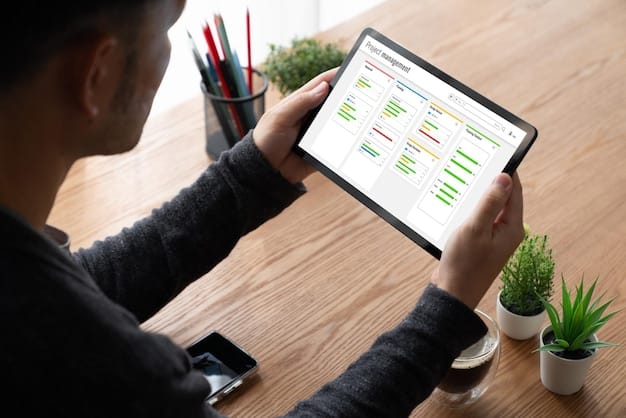Budgeting for Life’s Surprises: How to Handle Unexpected Expenses

Budgeting for unexpected expenses involves creating a financial plan to accommodate unforeseen costs, such as medical bills or home repairs, ensuring financial stability and peace of mind.
Life is full of surprises, and unfortunately, not all of them are pleasant. Unexpected expenses can throw even the most carefully planned budget into disarray. That’s why understanding how to budget for unexpected expenses: preparing for life’s surprises is a crucial skill for financial stability.
Understanding the Nature of Unexpected Expenses
Unexpected expenses are costs that arise suddenly and are not accounted for in your regular budget. These can range from minor inconveniences to major financial setbacks. Recognizing the different types of unexpected expenses is the first step in preparing for them.
These expenses can be categorized broadly. By understanding these categories, you can better plan for the types of surprises life might throw your way.
Common Categories of Unexpected Expenses
Understanding the common categories can help you anticipate and prepare for these financial surprises proactively.
- Medical Expenses: These can include emergency room visits, unexpected illnesses, or dental work. Even with good insurance, co-pays, deductibles, and uncovered procedures can add up quickly.
- Home Repairs: A leaky roof, a broken appliance, or a burst pipe can all lead to significant and unplanned costs. Homeownership comes with the responsibility of maintaining the property, and repairs are often unpredictable.
- Car Repairs: Like homes, cars require maintenance and are prone to breakdowns. Unexpected car repairs can range from a flat tire to major engine work, all of which can be costly.
- Job Loss: Losing a job is a major unexpected event that can significantly impact your finances. Preparing for this possibility is crucial for maintaining financial stability.
It’s important to remember that while you can’t predict exactly when these expenses will occur, understanding the potential for them is key to effective budgeting.

Building an Emergency Fund
The cornerstone of budgeting for unexpected expenses is building an emergency fund. This is a dedicated savings account used solely for unforeseen costs. It acts as a financial cushion, preventing you from going into debt or derailing your long-term financial goals when surprises arise.
Determining the right size for your emergency fund is a critical step. While the ideal amount varies depending on individual circumstances, there are some guidelines to consider.
How Much Should You Save?
Aiming to cover 3-6 months of essential living expenses is a common recommendation. This provides a buffer to cover costs such as housing, food, utilities, and transportation if you were to lose your job or face a significant unexpected expense.
- Calculate Your Monthly Expenses: Start by adding up all your essential monthly expenses. This includes rent or mortgage, utilities, groceries, transportation, and any other recurring costs necessary for your survival.
- Multiply by 3-6 Months: Once you have your total monthly expenses, multiply that number by 3 to get the low end of your emergency fund range, and by 6 to get the high end.
- Adjust Based on Your Situation: Consider your job security, health, and other personal circumstances. If you work in a stable industry and have good health insurance, you might be comfortable with a smaller emergency fund. If your job is less secure or you have a chronic health condition, a larger fund might be more prudent.
Building an emergency fund takes time and discipline, but it’s an invaluable tool for managing unexpected expenses and maintaining financial security.
Creating a Realistic Budget
A well-structured budget is the foundation for managing your finances and preparing for unexpected expenses. It provides a clear picture of your income, expenses, and savings goals, allowing you to identify areas where you can save money and allocate funds for emergencies.
Creating a budget involves tracking your income and expenses, categorizing your spending, and setting realistic financial goals.
Tracking Income and Expenses
The first step in creating a budget is to track your income and expenses. This will give you a clear understanding of where your money is coming from and where it’s going.
There are several methods for tracking your finances. Choose the one that works best for you and stick with it consistently.
- Spreadsheets: Using a spreadsheet program like Excel or Google Sheets allows you to create a customized budget template and track your income and expenses manually.
- Budgeting Apps: Numerous budgeting apps are available that can automatically track your spending, categorize transactions, and provide insights into your financial habits.
- Notebook and Pen: A simple notebook and pen can also be effective for tracking your spending. Write down every expense as it occurs and categorize it later.
Consistency is key when tracking your income and expenses. The more data you gather, the more accurate and useful your budget will be.
Strategies for Saving Money
Finding ways to save money in your daily life can free up funds to build your emergency fund and create a buffer for unexpected expenses. Even small savings can add up over time and make a significant difference in your financial security.
There are many strategies for saving money, from cutting back on discretionary spending to finding better deals on essential expenses.
Reduce Discretionary Spending
Discretionary spending refers to non-essential expenses like dining out, entertainment, and impulse purchases. Reducing these expenses can free up a significant amount of money in your budget.
- Eat at Home More Often: Cooking meals at home is generally much cheaper than eating out. Plan your meals, shop with a list, and avoid impulse purchases at the grocery store.
- Find Free or Low-Cost Entertainment: Look for free events in your community, take advantage of library resources, or explore outdoor activities like hiking or biking.
- Cut Unused Subscriptions: Review your subscriptions and cancel any that you don’t use regularly.
By consciously reducing discretionary spending, you can redirect those funds toward your emergency fund or other financial goals.

Prioritizing and Planning for Potential Expenses
While you can’t predict every unexpected expense, you can identify potential risks and plan accordingly. This involves assessing your vulnerabilities and prioritizing expenses based on their likelihood and potential impact.
Think about potential costs that might come up due to your lifestyle.
Assessing Potential Risks
Identifying potential risks involves considering your personal circumstances and the likelihood of various unexpected expenses.
Considering your personal vulnerabilities can make you more prepared.
- Homeowners: Homeowners should consider the potential for repairs to their roof, plumbing, appliances, and other systems.
- Car Owners: Car owners should anticipate the possibility of maintenance, repairs, and accidents.
- Individuals with Health Issues: Individuals with chronic health conditions should plan for potential medical expenses.
By assessing your potential risks, you can prioritize your savings and create a plan to address these expenses if they arise.
Utilizing Technology and Automation
Technology can be a powerful tool for budgeting and saving for unexpected expenses. Automation can help you stay on track with your financial goals and make saving money a seamless part of your routine.
Consider automating your savings for greater ease.
Automated Savings and Budgeting Tools
Set up automatic transfers from your checking account to your emergency fund to make saving a consistent habit. Many banks and budgeting apps offer features that automate this process.
- Set Up Recurring Transfers: Schedule regular transfers from your checking account to your savings account. Even small amounts can add up over time.
- Use Round-Up Apps: Some apps round up your purchases to the nearest dollar and transfer the difference to your savings account.
- Take Advantage of Employer-Sponsored Programs: If your employer offers a retirement savings plan with matching contributions, take advantage of it. This is essentially free money that can help you build your savings.
By using technology and automation, you can make saving for unexpected expenses easier and more effective.
| Key Point | Brief Description |
|---|---|
| 💰 Emergency Fund | Save 3-6 months of living expenses. |
| 📝 Realistic Budget | Track income, expenses, and set goals. |
| ✂️ Cut Spending | Reduce non-essential expenses. |
| 🤖 Automate Savings | Set up automated transfers. |
Frequently Asked Questions (FAQ)
▼
Aim to save 3-6 months’ worth of essential living expenses in your emergency fund. This provides a financial cushion for unexpected job loss or medical emergencies.
▼
Unexpected expenses can include car repairs, home repairs, medical bills, sudden job loss, or emergency travel. These are costs you didn’t anticipate in your regular budget.
▼
Start by setting a small, achievable savings goal. Cut back on non-essential spending and automate regular transfers to your emergency fund account to build it quickly.
▼
Using credit cards can be an option, but be cautious about accumulating debt. If you use a credit card, make sure to pay it off as quickly as possible to avoid high interest charges.
▼
Review your budget at least once a month to track your progress, identify areas for improvement, and adjust as needed. Regular review helps you stay on track with your financial goals.
Conclusion
Budgeting for unexpected expenses is a critical aspect of financial planning. By building an emergency fund, creating a realistic budget, saving money, prioritizing potential expenses, and utilizing technology, you can prepare for life’s surprises and maintain financial stability.





